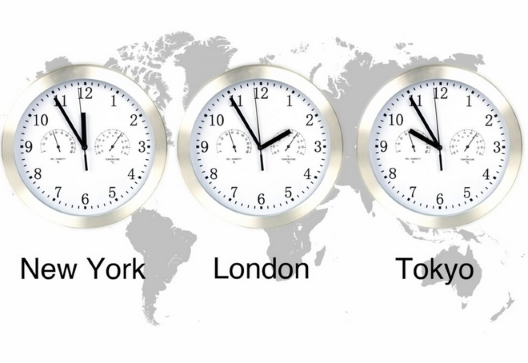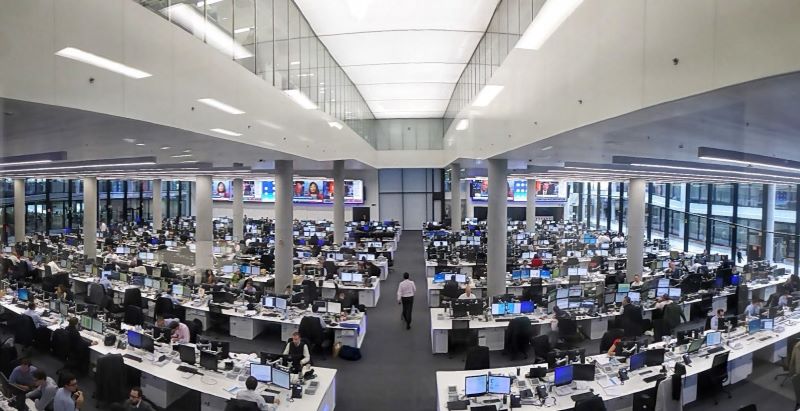The Forex market operates 24 hours a day making it one of the world’s most dynamic financial markets. Unlike the equity market with its fixed trading hours, Forex trading takes place throughout the day across several global financial centers, allowing for ongoing market making.
In this concise article by Axcess FX, we will look at how time zones affect Forex trading, including determining volatility and liquidity, how different trading sessions interact and how market activity varies during the day.

The Forex Market: Structure and Time Zones
The Forex market structure is fully decentralized with no single exchange or central location. Trading instead, takes place OTC (Over The Counter) electronically via a global network of banks, financial institutions, and institutional and retail traders.
Global Investment banks lead the way in providing market making on spot, forward and option desks. According to Euromoney, UBS, JP Morgan and Deutsche Bank were the leading Foreign Exchange banks accounting for 30% of transactions. UBS also won the GW Platt FX award for 2024 in the category of best global Foreign exchange Bank.
The FX market follows three major trading sessions in London, New York and Tokyo with the major Forex banks operating in all the centers. As you can see in the table below, there is a 24 hour overlap of the different centers. It is know as the “Forex Three Session System”, although there is also some importance tied to a Sydney session which closely overlaps the Tokyo session, with liquidity focused on the AUD and NZD.
| Session | Core Trading hours (UTC) |
|---|---|
| London (European) | 7 AM to 5 PM |
| New York (North American) | 12 PM to 10 PM |
| Tokyo (Asian) | 10 PM to 9 AM |
The major banks tend to have one Forex trading book which passes to the relevant desk once the trading day finishes in their session. For example, when I used to work on the Forex trading floor at UBS London, the EUR/USD spot desk in London passes on their book to New York when London winds down at 5 pm and then in turn passes to Tokyo as the New York session winds down.

Breaking Down The Major Forex Trading Sessions
The time zones of these trading sessions determine market activity levels, greatly influencing how currency pairs behave which we will look into now.
London Session
- Considered the most important Forex session due to high trading volume.
- Operating hours: 7 AM – 5 PM UTC.
- Key characteristics:
- Most liquid session, leading to tighter spreads and lower trading costs.
- High volatility, especially during the first few hours when major European economic reports are released.
- Key currency pairs: EUR/USD, GBP/USD, and USD/CHF.
New York Session
- The second-largest Forex market in terms of volume and influence.
- Operating hours: 12 PM – 10 PM UTC.
- Key characteristics:
- Some overlap with the London afternoon session, leading to increased volatility and high liquidity.
- Major economic data releases from the U.S. drive market movements.
- Currency pairs like USD/CAD and USD/JPY see increased activity.
The Tokyo Session
- Creates continuous market activity.
- Operating hours: 10 PM – 9 AM UTC.
- Key characteristics:
- Strong activity in JPY-related pairs like USD/JPY, EUR/JPY, and GBP/JPY.
- The Bank of Japan’s monetary policy decisions can significantly impact movements.
- Less liquidity compared to the London and New York sessions, but still offers trading opportunities.
Session Overlaps and Market Volatility
Forex trading operates 24 hours a day, but liquidity and volatility vary depending on the time of day. Some of the most volatile trading periods align with the opening and overlap of the major financial markets with increased liquidity as traders from multiple financial centers engage in transactions.
The two key overlaps are:
London & New York (12 PM – 4 PM UTC)
- The most volatile period, with major currency pairs like EUR/USD and GBP/USD experiencing sharp movements, the overlap offers high liquidity and trading opportunities, great for day traders looking for strong price action.
Tokyo & London (7 AM – 9 AM UTC)
- The overlap offers lower liquidity, but still notable movements in EUR/JPY and GBP/JPY.
Traders must be aware of these overlaps to optimize their entry and exit points. Overlaps are also useful for part-time traders who can focus on peak hours that align with their availability to maximize efficiency
Daylight Saving Time (DST) and Its Effects
What is DST?
Daylight Saving Time is the practice of setting your clocks forward by an hour in the summer and then back an hour in the winter. It affects trading hours in various countries, including the U.S. and U.K.
DST’s Impact on Forex Trading:
As DST changes the opening and closing times of trading sessions it can create confusion if traders do not adjust their schedules accordingly. Market volatility may then increase during transition periods as traders adapt to the new hours.
Tips for Adjusting Trading Strategies during DST
Consider the following four tips to avoid unexpected problems during DST:
- It is good practice to use Forex market hour indicators that automatically adjust for DST.
- Always be mindful of the exact date when major financial centers switch to or from Daylight Saving Time..
- Consider monitoring liquidity changes around DST transitions to avoid any unnecessary risk.
- Try and plan trades in advance, particularly for economic events that may coincide with DST shifts.
Time Zone Conversion Tools
Keeping track of global Forex market hours is essential for effective trading and useful tools include:
- Forex market hour indicators: MetaTrader 4/5 plugins, TradingView indicators.
- Online time zone converters: ForexFactory Market Hours, World Time Buddy.
- Economic calendars: Websites like Investing.com and Forex Factory provide session timings and key events.
Traders should regularly check these tools, especially when Daylight Saving Time (DST) changes occur.
Related Resources
How is an Investment Bank Forex Trading Floor Set Up?
An Insight Into The Global Forex Market
Written by Chris Gillie

Chris Gillie is the founder of Axcess FX, a Forex software review and research website. He is a former investment banker who worked in FX Sales on the UBS London trading floor. Chris has been using Forex trading software as part of his trading set-up since the late 2000s and the embryonic days of MetaTrader and the MQL coding language.


